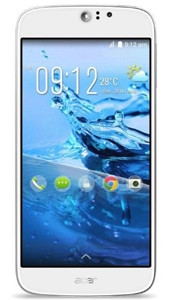
Acer's smartphones typically feature entry-level specifications combined with eye-catching designs. The recently introduced Liquid Jade is no exception to that rule since it offers an elegant exterior but lacks powerful hardware. So it's got the looks, but can it keep up with business needs?
To uncover the answer, we worked with a review-sample for a couple of days and primarily deployed it to do all sorts of business-related tasks and activities. We used the device for various forms of communication, browsing the Internet and handling typical office-documents. We also ran various performance benchmarks, tested the stamina of the battery, and measured the quality of the screen with dedicated equipment. Camera quality was ascertained by shooting a series of photos and videos under various conditions.
Look and feel: feels good, but lacks grip
The Acer Liquid Jade has a pleasant and slightly curved design. Although the backside is entirely made out of cheap-feeling plastic, the slimline (7.5mm) and lightweight (110g) exterior is responsible for a comfortable feel in the hand.
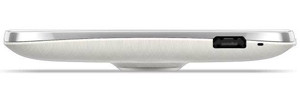
Unfortunately, the device lacks good grip and tends to slip out of your hands. The protruding rear camera lens can be used to regain some of that grip but mainly prevents the handset from being comfortably used when flat on its back.
Acer managed to keep the bezels on both sides of the screen compact, making it well-suited to be used with one hand. The position of the power-button, however, is problematic. It is located at the top of the device, requiring some effort to reach it, regardless of which hand you are holding it in.
On the left side, it accepts either two simultaneous Nano SIM cards, or one in combination with an optional micro-SD memory card. Since it only has 8GB of storage space, most business users will probably go for the extra space, rendering the dual-SIM feature irrelevant.
Hardware and benchmarks: poor performer
The Liquid Jade uses a MediaTek MT6582 chip that houses four Cortex-A7 cores each running at a maximum of 1.3GHz. For graphics, the device relies on an ARM Mali-400 GPU. It's got only 1GB of RAM and from the scanty 8GB of storage space only 5.5GB is actually available for user content. It doesn't support 4G/LTE, NFC and 5GHz WiFi networks, but is able to connect to a Bluetooth device.
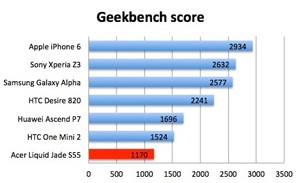
Although on paper these specifications are far from impressive, we were still keen to find out how the hardware would perform when faced with our benchmark software. We started off with Geekbench, which simulates real-world business and consumer scenarios to determine and quantify the actual (multi-core) processing power. Then we ran the Kraken JavaScript benchmark to measure the hardware, operating system and browser. Finally, we deployed 3DMark to quantify the graphics power.
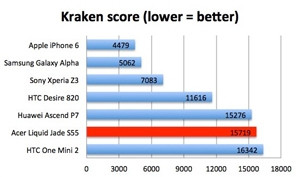
To keep the comparison honest and interesting, we stacked the device up to (roughly) similar-sized and priced, as well as more expensive, high-end smartphones.
According to Geekbench, Acer's smartphone is the slowest of the bunch. It is even considerably slower than the roughly similarly priced 4.5-inch HTC One Mini 2, 5-inch Huawei Ascend P7 and 5.5-inch HTC Desire 820 devices. The Kraken JavaScript benchmark showed it performed marginally better than the HTC One Mini 2, but couldn't beat the Huawei Ascend P7. Both the 4.7-inch Samsung Galaxy Alpha and Apple iPhone 6 showed the best performance during this test run.
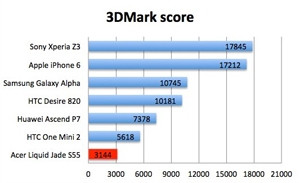
3DMark put the phone's graphics performance to shame compared to the other devices. Sony's 5.2-inch Xperia Z3 proved to be the best choice for graphics-intense apps and games.
In the end, our initial suspicions were confirmed by these three benchmarks. The handset is a relatively poor performer, even when compared to smartphones with nearly identical price tags. In absolute terms, it will only be suitable for light office tasks and not too much multi-tasking. Demanding business users should avoid this smartphone.
Battery life: full day at the office
Battery life is a key consideration for business users, as it means less dependency on a power source or charger. Acer equipped the Liquid Jade with a 2100mAh (non-removable) battery. With the exception of HTC's One Mini 2 (1860mAh), similar-sized and priced devices offer slightly higher capacity batteries (2600mAh).
Since this handset doesn't deliver a lot of processing power, it could implicate longer battery life as a result. To find out if that logic sticks, we ran the device through two separate torture-tests that aim to drain the battery as fast as possible. The first test simulates continuous business use like communicating, browsing and editing documents. The second test continuously plays a 1 080p video until there is no energy left.
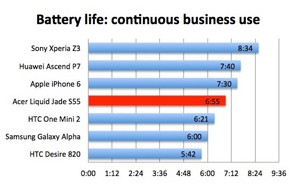
According to our test results, the phone is able to hold out for almost seven hours when continuously being used for typical office tasks. It is even able to outlast the slightly more expensive Galaxy Alpha (six hours). Since a typical day at the office also includes at least one break and some idle time, we expect it to have no problem reaching the end of an eight-hour workday and still have some energy left.
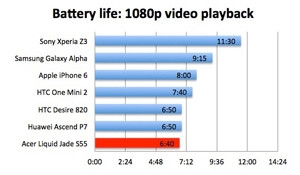
Watching non-stop HD-video is, however, not its strong point. We clocked it at six hours and 40 minutes. Huawei's Ascend P7 and HTC's Desire 820 each lasted marginally longer (6:50) on a fully charged battery. All the other devices performed significantly better, making them more suitable to be used during a long overseas flight.
Screen: inaccurate colours
The phone features a 5-inch screen with a resolution of 1 280 x 720 pixels, resulting in a 294ppi density. As a result, text and images look pretty sharp. The screen has been supplied with Gorilla Glass technology that should provide it with better scratch-resistance.
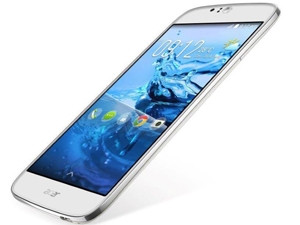
We used our SpectraCal C6 colorimeter to measure the screen's brightness, contrast and colour reproduction. The maximum brightness levels (410cd/m^2) are nothing to complain about, so it can comfortably be used in direct sunlight. Viewing angles are adequate inside the office, but aren't that good when the device is in direct sunlight.
Contrast values are also quite high, resulting in vivid and lively colours. The only aspect that leaves much room for improvement is the reproduction of accurate colours. Red is underrepresented while the screen tends to show too much blue. Usually inaccurate reproduction of certain colours is hardly noticeable on modern mobile devices, but they are on this gadget.
Camera: steady hands required
Considering its price, the Liquid Jade S55 features a relatively high-resolution 13MP rear camera with auto-focus, face detection, High Dynamic Range (HDR) support and LED-flash. This rear cam can take pictures in a 4 224 x 3 168 resolution and will capture video in 1 920 x 1 080 (Full-HD) format at 30 frames per second. It doesn't have superior optical image stabilisation technology on board, like some expensive, high-end smartphones, but relies on its software to compensate for shaky hands.
The test pictures we shot using the rear camera proved more than sufficient for the occasional corporate meeting, business trip or office birthday party. They were, however, a bit on the dark side. The on-board LED-flash doesn't do a great job during light-deprived situations and needs help from external light sources. It's also important to keep the device as steady as humanly possible.
Unfortunately, the front camera features a much lower 2MP resolution, but is still able to capture images at 2 048 x 1 152 and facilitates a decent Skype call. Unfortunately, it also doesn't do well in dark situations.
On the upside, both cameras work intuitively and quick. Auto-focus is close to instant and pictures are taken in a breeze. The camera software features loads of options to play and experiment with, like burst and panorama mode.
Verdict
So, can this smartphone keep up with your business? Probably not, unless you only plan to use it for light office tasks and not too much multi-tasking. Most business users will quickly find the Liquid Jade to be a limited device, both in storage capacity and hardware capabilities. Nonetheless, it does offer good looks, an all-day-long battery life, a compact and lightweight ergonomic design and a high-resolution rear camera.
The fact remains that for a slightly higher budget, significantly superior smartphones are available that offer better hardware, more storage space and 4G/LTE/NFC and 5GHz WiFi support.
Share